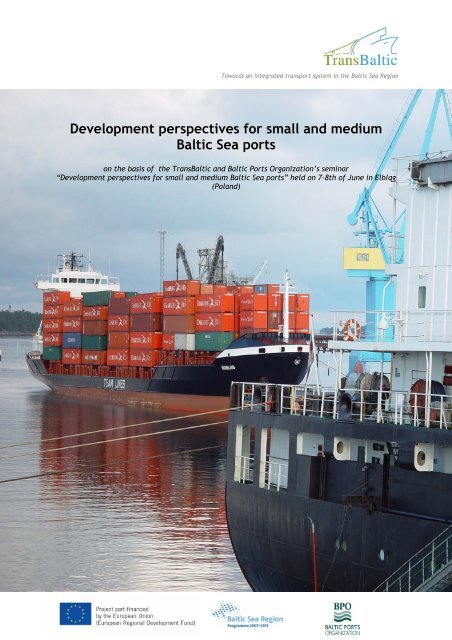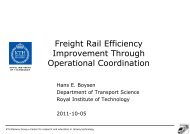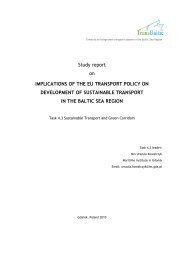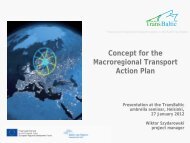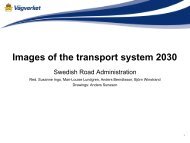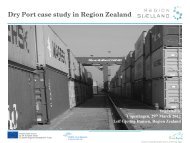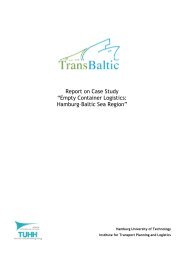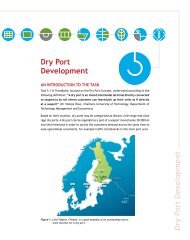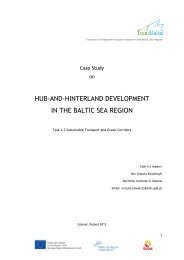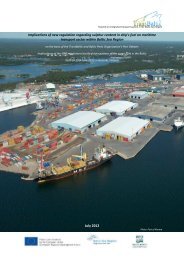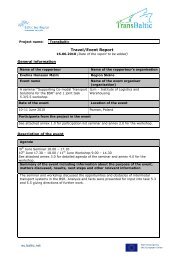Development perspectives for small and medium Baltic ... - TransBaltic
Development perspectives for small and medium Baltic ... - TransBaltic
Development perspectives for small and medium Baltic ... - TransBaltic
Create successful ePaper yourself
Turn your PDF publications into a flip-book with our unique Google optimized e-Paper software.
Towards an integrated transport system in the <strong>Baltic</strong> Sea Region<br />
<strong>Development</strong> <strong>perspectives</strong> <strong>for</strong> <strong>small</strong> <strong>and</strong> <strong>medium</strong><br />
<strong>Baltic</strong> Sea ports<br />
on the basis of the Trans<strong>Baltic</strong> <strong>and</strong> <strong>Baltic</strong> Ports Organization’s seminar<br />
“<strong>Development</strong> <strong>perspectives</strong> <strong>for</strong> <strong>small</strong> <strong>and</strong> <strong>medium</strong> <strong>Baltic</strong> Sea ports” held on 7-8th of June in Elbląg<br />
(Pol<strong>and</strong>)
Towards an integrated transport system in the <strong>Baltic</strong> Sea Region<br />
July 2011<br />
Report coordinator: <strong>Baltic</strong> Ports Organization Secretariat<br />
Authors:<br />
Monika Rozmarynowska – academic teacher at Gdynia Maritime Academy<br />
Bogdan Ołdakowski, BPO Secretary General<br />
<strong>Baltic</strong> Ports Organization is made up of <strong>for</strong>ty plus major ports in the nine countries surrounding the<br />
<strong>Baltic</strong> Sea. The main objective of BPO is to improve the competitiveness of maritime transport in<br />
the <strong>Baltic</strong> region by increasing the efficiency of ports, marketing the <strong>Baltic</strong> region as a strategic<br />
logistics centre, improving the infrastructure within the ports <strong>and</strong> their connections to other modes<br />
of transport.<br />
Trans<strong>Baltic</strong>, as one of the few transnational projects so far, has been granted a strategic status by<br />
the authorities of the <strong>Baltic</strong> Sea Region Programme 2007-2013. The overall objective of Trans<strong>Baltic</strong><br />
is to provide regional level incentives <strong>for</strong> the creation of a comprehensive multimodal transport<br />
system in the BSR. This is to be achieved by means of joint transport development measures <strong>and</strong><br />
jointly implemented business concepts. Trans<strong>Baltic</strong> is led by Region Skåne <strong>and</strong> lasts from 1 June<br />
2009 to 31 December 2012.<br />
2
Towards an integrated transport system in the <strong>Baltic</strong> Sea Region<br />
Table of Contents<br />
1. Introduction .............................................................................................. 4<br />
2. Small <strong>and</strong> <strong>medium</strong> size ports in the <strong>Baltic</strong> ........................................................ 5<br />
2.1. Port management in EU <strong>and</strong> in <strong>Baltic</strong> countries........................................ 5<br />
2.2. Market position of <strong>small</strong> <strong>and</strong> <strong>medium</strong> <strong>Baltic</strong> ports..................................... 10<br />
3. Case studies ......................................................................................... 12<br />
3.1. Port of Elbląg (Pol<strong>and</strong>)................................................................ 13<br />
3.2. Port of Kołobrzeg (Pol<strong>and</strong>).............................................................. 15<br />
17<br />
3.3. Port of Kalajoki (Finl<strong>and</strong>)............................................................<br />
3.4.Port of Naestved (Denmark)...................................................... 18<br />
3.5.Port of Oskarshamn (Sweden)........................................................ 19<br />
3.6. Ports of Brunsbüttel (Germany)..................................................... 20<br />
4. Summary.................................................................................................. 22<br />
5. Recommendations................................................................................... 22<br />
3
Towards an integrated transport system in the <strong>Baltic</strong> Sea Region<br />
Introduction<br />
The report has been prepared on the basis of presentations presented at Trans<strong>Baltic</strong> <strong>and</strong> <strong>Baltic</strong><br />
Ports Organization’s seminar – “<strong>Development</strong> <strong>perspectives</strong> <strong>for</strong> <strong>small</strong> <strong>and</strong> <strong>medium</strong> <strong>Baltic</strong> Sea ports”<br />
held on 7-8 th of June in Elbląg (Pol<strong>and</strong>). However, in<strong>for</strong>mation from other sources also have been<br />
used in this report.<br />
Seminar speakers represented e.g. port authorities, external experts <strong>and</strong> public administration from<br />
Pol<strong>and</strong>, Denmark, Finl<strong>and</strong>, Sweden <strong>and</strong> Germany. The seminar focused on such aspects as <strong>small</strong> <strong>and</strong><br />
<strong>medium</strong> port management, financing tools, good practice dissmination as well as legal issues <strong>and</strong><br />
plat<strong>for</strong>m co-operations. The seminar also intend to investigate <strong>perspectives</strong> <strong>for</strong> broader<br />
transportation flows through Vistula Lagoon where Port of Elbląg is located.<br />
In the first part of the report the ports‘ management models were described <strong>and</strong> some examples<br />
were presented. Furthermore, this part deals with the position of the <strong>small</strong> <strong>and</strong> the <strong>medium</strong> ports in<br />
the <strong>Baltic</strong> Sea region.<br />
In the second part of the report case studies were presented. Five <strong>small</strong> <strong>Baltic</strong> ports were<br />
described, two polish ports – Elbląg <strong>and</strong> Kołobrzeg, one Finish port - Kalajoki, one Danish port -<br />
Naestved <strong>and</strong> one Swedish port – Oskarshamn. The average throughput of this ports is about several<br />
hundred tonnes per year. All of this ports are still developing. Their development plans assume e.g.<br />
construction of new quays or modernization of existing ones, construction of new storage area.<br />
Apart from <strong>small</strong> <strong>Baltic</strong> ports, one German port was presented – Brunsbüttel. Direction of<br />
development of this port is mostly connected with offshore sector.<br />
4
Towards an integrated transport system in the <strong>Baltic</strong> Sea Region<br />
2. Small <strong>and</strong> <strong>medium</strong> size ports in the <strong>Baltic</strong><br />
2.1. Port management in EU with the focus on <strong>Baltic</strong> countries<br />
The analysis presented below discusses port management systems in the Member States of the<br />
European Union. However, we deal in more detail with port management in <strong>Baltic</strong> countries. We<br />
have investigated the problem using the documents of the <strong>Baltic</strong> Ports Organization (BPO), European<br />
Sea Ports Organization (ESPO), World Bank <strong>and</strong> selected references on the subject. Furthermore, we<br />
extended our sources by in-depth interviews <strong>and</strong> discussions with representatives of ports <strong>and</strong><br />
national port organizations in EU countries.<br />
Basic port management models<br />
Present-day sea port management systems in the EU Member States have developed over the<br />
centuries. They are unique in each of the countries. They have been affected by cultural, social <strong>and</strong><br />
economic processes undergoing in individual European countries. Besides, the functioning of the<br />
port sector in a country have depended on a state management <strong>for</strong>m: in countries where the state<br />
plays a major role, more centralized port management systems dominate, while in countries with<br />
decentralizing tendencies port management is at a lower level as it is h<strong>and</strong>led by regional or local<br />
governments.<br />
It tends to be somewhat more difficult to classify port management systems in countries that<br />
regained their independence or sovereignty after the fall of Communism such as Estonia, Lithuania,<br />
Latvia, Pol<strong>and</strong>, Bulgaria <strong>and</strong> Romania. These countries introduced legal regulations in the 1990s or<br />
in the first decade of 2000 <strong>and</strong> created central port management systems with some self-governing<br />
elements.<br />
Present-day port management systems have emerged out of the three basic models:<br />
• Hanseatic model,<br />
• Latin model,<br />
• Anglo-Saxon model.<br />
The Hanseatic model originated from what is known as the Hanseatic League where trade among<br />
Northern Europe countries grew dynamically. With the trade growing, ports <strong>and</strong> cities developed to<br />
<strong>for</strong>m a common social <strong>and</strong> economic organism. The Latin model which was used to build port<br />
management systems has been functioning primarily in the European part of the Mediterranean Sea.<br />
It is a centralized system with the role of a central government prevailing. The Anglo-Saxon model<br />
was used to create port management boards in the United Kingdom where private ownership in sea<br />
port management companies dominates.<br />
Sea port management systems operate based on these models. They “involve all the legal <strong>and</strong><br />
organizational, administrative, economic <strong>and</strong> financial, technical <strong>and</strong> spatial, <strong>and</strong> social <strong>and</strong><br />
5
Towards an integrated transport system in the <strong>Baltic</strong> Sea Region<br />
environmental relationships that have been established between a management entity (owner) <strong>and</strong><br />
an object (port business organism)” 1 .<br />
Overview of management systems in selected EU sountries<br />
In 2000, Petri 2 reviewed <strong>for</strong>ms of sea port management in the EU countries taking into account<br />
public administration (engaged in management) <strong>and</strong> analyzed port ownership <strong>for</strong>ms. Likewise, ESPO<br />
made an in-depth analysis of sea port management 3 in 2005 <strong>and</strong> 2010. Table 1 shows the results of<br />
the investigations.<br />
Table 1: Engagement of public entities in sea port management in EU countries (based on Pietri,<br />
2000, <strong>and</strong> ESPO, 2005)<br />
Denmark<br />
Denmark has mainly municipal ports which operate as unsepareted or separate entities in the<br />
organisational structure of a city, or as companies with cities as their shareholders. In addition,<br />
there are companies managing ports in place with shareholders being both private entities <strong>and</strong><br />
1 Grzelakowski A. ,“European Sea Port Management Systems <strong>and</strong> Models: Recommendations <strong>for</strong> Pol<strong>and</strong>”. A<br />
report at the Gdańsk Conference on the Management of Large Sea Ports in the Context of Rights of a Local<br />
Government, 22 June 2009.<br />
2 Pietri, J-M. “L’Etude de l’ESPO sur la ‘Situation de fait’ dans les principaux ports maritimes européens”.<br />
Exposé présenté à la reunion de l’ADPF du 4 Mars 1997 (révisé et complete le 18 Septembre 2000).<br />
3 ESPO. European Port Governance Report & ESPO. Factual Report on the European Port Sector 2004-2005.<br />
2005 <strong>and</strong> 2010.<br />
6
Towards an integrated transport system in the <strong>Baltic</strong> Sea Region<br />
municipalities (mixed ownership) <strong>and</strong> private ports. In each of these cases, port management<br />
entities have to carry out separate bookkeeping <strong>and</strong> financial reporting.<br />
Pursuant to the Danish law that governs port activities (the Port Act of 2000), municipal ports are<br />
controlled by local municipal councils. Ports are responsible <strong>for</strong> the extension <strong>and</strong> maintenance of<br />
port infrastructure while private entities carry out operations.<br />
The central government in Denmark does not supervise sea ports.<br />
However, in 2010 the Danish Government initiated the discussion on re<strong>for</strong>ms that focused on the<br />
competitiveness <strong>and</strong> efficiency of the ports in Denmark. The discussion should end up with<br />
recommendations to modify the Port Act.<br />
The Danish legislation framework does not distinguish between <strong>small</strong> <strong>and</strong> large ports, so the<br />
majority of the <strong>small</strong> ports are owned by municipalities.<br />
Sweden<br />
In Sweden, there are predominantly municipal ports. Sweden does not have any special laws<br />
concerning port activities. Port management entities operate under commonly established rules of<br />
the Swedish commercial law.<br />
The Swedish port system is unique in the whole of Europe. As opposed to the division into the<br />
sphere of management <strong>and</strong> operations prevailing in Europe, Swedish port management entities carry<br />
out operations as well. The idea of integrated ports emerged in Sweden in the 1970s <strong>and</strong> was<br />
initiated predominantly by political factions <strong>and</strong> local administration. The process of integrating the<br />
sphere of management <strong>and</strong> operations (then private ownership) resulted from the conviction that it<br />
would lead to increased efficiency <strong>and</strong> reduced operating expenses. The process was carried out<br />
with the support of trade unions as operating companies often had financial problems, <strong>and</strong> the<br />
integration of activity allowed <strong>for</strong> cost optimization.<br />
Currently, a reverse trend can be observed, particularly in bigger ports. In March 2009, Ports of<br />
Stockholm signed an agreement with Hutchison Port Holdings (one of the largest container port<br />
operators in the world) on taking over the activity involving container h<strong>and</strong>ling. In future, Hutchison<br />
PH will operate in the new port terminal to be built in Nynäshamn (about 60 km from Stockholm).<br />
Also, the other operating activities in the port of Stockholm were separated from the management<br />
entity. Stockholm Stevedoring <strong>and</strong> Staffing AB is currently in the process of selling to a private<br />
investor. Also, pursuant to the decision of the City Council of Gothenburg, in 2009 Port Göteborg<br />
announced that operations would be separated from the port structure. The target Port of Göteborg<br />
entity will function as a management board (the Gothenburg Port Authority) <strong>and</strong> three terminal<br />
operators, Älvsborg Ro/ro AB, Gothenburg Car Terminal AB <strong>and</strong> Sk<strong>and</strong>ia Container Terminal AB.<br />
Operators’ companies will be sold to private investors. Thus, we can assume that the two ports as<br />
well as the Port of Malmö operate as l<strong>and</strong>-lord ports.<br />
Finl<strong>and</strong><br />
Like in other Sc<strong>and</strong>inavian countries, Finl<strong>and</strong> ports are governed by cities. They have the l<strong>and</strong>-lord 4<br />
port status. Beside municipal ports, there are also private ports h<strong>and</strong>ling industrial activities<br />
located near the port (most often, refining <strong>and</strong> timber industries). The majority of ports are<br />
integrated with the municipal administration; some of them <strong>for</strong>m separated local entities that<br />
manage their own financial reporting. However, a process of separating port activities from<br />
4 Hilska Lassi. “Port Legislation <strong>and</strong> Cooperation between Authorities”. A Report at the Northern Maritime<br />
Challenge. Helsinki, Finl<strong>and</strong>. 2010,<br />
7
Towards an integrated transport system in the <strong>Baltic</strong> Sea Region<br />
municipal administration <strong>and</strong> setting up commercial law companies with cities as shareholders has<br />
been observed recently.<br />
This is caused by the 2007 decision of European Commission on state aid rules in Finnish public<br />
enterprises. As a consequence, Finnish port authorities must be corporatized by the beginning of<br />
2014. This entails a series of consequences <strong>for</strong> <strong>small</strong> ports as well that will have to finance<br />
development projects at their own risk <strong>and</strong> using their own resources.<br />
Estonia<br />
Pursuant to the laws of Estonia, public, municipal <strong>and</strong> private ports alike can operate in the<br />
country. Port management entities function as commercial law companies in accordance with<br />
commonly applicable regulations. Under the Estonian law that governs port activities, a port<br />
management board has l<strong>and</strong> within its borders <strong>and</strong> organizes as well as manages port activities; in<br />
particular it maintains port infrastructure, port canals <strong>and</strong> navigational markings, <strong>and</strong> supervises<br />
safety <strong>and</strong> environmental protection in the port.<br />
The largest port in Estonia, the Port of Tallinn, manages several ports in the country such as the<br />
port in Tallinn, the port in Muuga <strong>and</strong> the port in Paldiski. The 100% owner of the Port of Tallinn is<br />
the central government, while direct supervision is carried out by the Ministry of Economy <strong>and</strong><br />
Communications. The port management board can be a shareholder or can establish affiliates both<br />
in the country <strong>and</strong> abroad.<br />
An example of a private port is Port of Sillamäe (a commercial name of Silport). It is located very<br />
close to the border with Russia. It has several terminals <strong>for</strong> h<strong>and</strong>ling general cargo <strong>and</strong> bulk cargo.<br />
Lithuania<br />
Klaipeda is a strategic port <strong>for</strong> the economy of Lithuania. The Klaipeda State Seaport Authority<br />
operates under a special law governing the port activities of 1996. The Port of Klaipeda operates<br />
according to the l<strong>and</strong>-lord model. Furthermore, the Ministry of Transport <strong>and</strong> Communications<br />
accepted a regulation governing the operations <strong>and</strong> rules of port navigation in the Port of Klaipeda.<br />
The Minister of Transport <strong>and</strong> Communications appoints <strong>and</strong> recalls a port director <strong>and</strong> approves<br />
financial statements. The Port Council (there are no supervisory functions) that prepares<br />
development plans <strong>for</strong> the port is composed of representatives of the Ministry of Transport <strong>and</strong><br />
Communications, the Ministry of Finance, the region <strong>and</strong> the city of Klaipeda, port management<br />
board <strong>and</strong> users.<br />
Also, the port structure includes the Port <strong>Development</strong> Council that prepares the development<br />
strategy of the port <strong>and</strong> coordinates the relations among the management entity, municipal<br />
administration in Klaipeda <strong>and</strong> governmental institutions. The Port <strong>Development</strong> Council is<br />
composed of representatives of the Ministry of Transport <strong>and</strong> Communications, the Ministry of<br />
Finance <strong>and</strong> other ministries, the region <strong>and</strong> the city of Klaipeda, academic representatives, port<br />
management board <strong>and</strong> users.<br />
Latvia<br />
The ports in Latvia operate pursuant to the port act of 1994 that makes them public institutions.<br />
Port management boards are non-profit institutions that have the l<strong>and</strong>-lord status: they manage<br />
infrastructure while private companies deal with operations. Moreover, the activities of the Port of<br />
Riga are provided <strong>for</strong> by the Act on the Free Port of Riga of 2001, while of the Port of Venstpils, by<br />
the Act on the Free Port of Ventspils of 1997.<br />
8
Towards an integrated transport system in the <strong>Baltic</strong> Sea Region<br />
A body managing the Port of Riga (the Free Port of Riga Authority) was <strong>for</strong>med by the Municipal<br />
Council of Riga <strong>and</strong> it is supervised by the government of Latvia. The Supervisory Board of the Free<br />
Port of Riga Authority is composed of city representatives (4 members) <strong>and</strong> the representatives of<br />
the ministries of transport, finance, environment <strong>and</strong> economy (4 members as well).<br />
Germany<br />
In Germany, there are many ownership <strong>for</strong>ms relating to port management entities, from private<br />
ports to ports managed by states <strong>and</strong> cities, <strong>and</strong> mixed <strong>for</strong>ms.<br />
Below we present a few examples of port management entities in Germany.<br />
Bremenports GmbH &Co. KG is a company <strong>for</strong>med in 2001 where the 100% owner is the Free<br />
Hanseatic City of Bremen. The city of Bremen has a status of a state. Bremenports GmbH & Co. KG<br />
manages ports in Bremen <strong>and</strong> Bremenhaven.<br />
In 2005, the state of Lower Saxony <strong>for</strong>med a company, Niedersachsen Ports GmbH & Co. KG to<br />
manage ports located along the coast of the state. Lower Saxony holds 100% of shares in the<br />
company.<br />
In 2005, a city <strong>and</strong> a state of Hamburg separated all administrative functions managing the port<br />
from the municipal structures <strong>and</strong> <strong>for</strong>med the Port Hamburg Authority to manage the Port of<br />
Hamburg. As opposed to the other port managing authorities presented above, the Port Hamburg<br />
Authority is not a company under commercial law but it is a public entity (it was <strong>for</strong>med under<br />
public law), although it has some features of a commercial entity, e.g. it collects fees <strong>for</strong> l<strong>and</strong><br />
lease.<br />
The ports in Rostock, Wismar, Sassnitz <strong>and</strong> Mukran located in Mecklenburg-Vorpommern are<br />
managed by commercial law companies with shareholders being the state of Mecklenburg-<br />
Vorpommern <strong>and</strong> the cities. For instance, the city of Rostock holds 74.9% shares <strong>and</strong> Mecklenburg-<br />
Vorpommern 25.1% in the entity managing the Port of Rostock, Hafen-Entwicklungsgesellschaft<br />
Rostock mbH.<br />
Small German ports are predominantly supervised by cities.<br />
Pol<strong>and</strong><br />
In Pol<strong>and</strong>, the Act on Seaports <strong>and</strong> Marinas of 1996 provides <strong>for</strong> the framework of port activities.<br />
The Act was used to establish port authorities <strong>for</strong> major ports accelerating state economy such as<br />
Ports of Gdańsk, Gdynia <strong>and</strong> Szczecin-Świnoujście. Since its promulgation, the act was amended a<br />
few times.<br />
Under the Act, the ownership of <strong>small</strong> ports had to be transferred to the city, but only in a few<br />
cases (Kołobrzeg, Darłowo, Hel <strong>and</strong> Elbląg) the process turned to be successful. The other <strong>small</strong><br />
ports are under administrative control of the maritime office or still included in the state-owned<br />
enterprise (Władysławowo).<br />
Summary<br />
Much diversified <strong>for</strong>ms of sea port management are found across the European Union. However,<br />
private ownership dominates while quite frequently mixed management <strong>for</strong>ms occur if the state <strong>and</strong><br />
local <strong>and</strong> regional governments exert some influence. Countries where local administration engages<br />
in port management are in Sc<strong>and</strong>inavia. Local <strong>and</strong> regional administration engages primarily in<br />
9
Towards an integrated transport system in the <strong>Baltic</strong> Sea Region<br />
countries where the Hanseatic management model prevails, that is, in Germany, Belgium <strong>and</strong> the<br />
Netherl<strong>and</strong>s. Also, in countries with a central management model such as France <strong>and</strong> Spain the<br />
participation of local governments is considerable, particularly in <strong>small</strong> ports. In recent years,<br />
decentralization processes in port management (Belgium <strong>and</strong> France) <strong>and</strong> a stronger engagement in<br />
management functions by local <strong>and</strong> regional governments have been observed. In most countries,<br />
<strong>small</strong> sea ports are supervised by local governments.<br />
Another important trend noted in EU is that public entities are separated from local governments<br />
e.g. the Port Hamburg Authority, or commercial law companies are <strong>for</strong>med to manage ports. The<br />
process is named corporatization 5 in specialist literature. Its aim is to give greater autonomy to<br />
managing entities (to join business projects as well) which increases equality <strong>and</strong> efficiency in<br />
dealing with customers <strong>and</strong> investors. Obviously, the original reason behind corporatization of ports<br />
is globalization processes <strong>and</strong> the greater <strong>and</strong> greater competition which <strong>for</strong>ce ports to use more<br />
business-quality st<strong>and</strong>ards in their management. Port management boards have to have a greater<br />
capability of being an active business player.<br />
The European Union has no directives or regulations whatsoever governing sea port management.<br />
Two attempts to pass what was called as the Port Package to govern the services inside the port<br />
ended in a fiasco due to protests of trade unions. However, a prevailing philosophy in port<br />
management in Europe relies on a l<strong>and</strong>-lord port model.<br />
2.2. Market position of <strong>small</strong> <strong>and</strong> <strong>medium</strong> <strong>Baltic</strong> ports<br />
There are over 200 ports in the <strong>Baltic</strong> Sea. If only those ports that h<strong>and</strong>le minimum 50 000 tonnes of<br />
cargo per year, <strong>and</strong> where at least part of this cargo is international, are taken into account the<br />
number of ports reaches approximately 190. All <strong>Baltic</strong> Sea ports h<strong>and</strong>le over 800 million tonnes of<br />
cargo annually. <strong>Baltic</strong> ports can be divided into four classes in terms of their total traffic volumes.<br />
There are about 20 big ports. Each h<strong>and</strong>les over 10 million tonnes annually. They participate in 64 %<br />
of total cargo turnover of all <strong>Baltic</strong> sea ports. Ports in the size class 5 -9.99 million tonnes<br />
participate in 15 % of total cargo turnover. Ports’ in class 2-4.99 million tonnes share in total cargo<br />
turnover is about 11 %. About 66 % of all <strong>Baltic</strong> sea ports are <strong>small</strong> ports which h<strong>and</strong>les less than 2<br />
million tonnes of cargo per year. However, their share in total cargo turnover of <strong>Baltic</strong> ports is<br />
only about 10 %. 6 The greatest number of <strong>small</strong> ports (0.05-1.99 million tonnes) where at least part<br />
of this cargo is international is in Sweden (about 44), Denmark (about 37) <strong>and</strong> Finl<strong>and</strong> (about 27).<br />
5 Verhoeven, P. “European Ports Policy: Meeting Contemporary Governance Challenges, Maritime Policy &<br />
Management”. 2009. 36:1, 79-101; Verhoeven, P. “Port Management Re<strong>for</strong>m in Europe: Is There a Role <strong>for</strong> the<br />
EU?”. 2007<br />
6 <strong>Baltic</strong> Port List 2008.<br />
10
Towards an integrated transport system in the <strong>Baltic</strong> Sea Region<br />
Table 2: Ports grouped into four size classes in terms of their total traffic volumes<br />
Size classes<br />
Over 10 million<br />
tonnes<br />
5-9.99 million<br />
tonnes<br />
2-4.99 million<br />
tonnes<br />
0.05-1.99<br />
million tonnes<br />
Share in total<br />
number of ports<br />
Share in cargo<br />
volumes<br />
11 % 64 %<br />
9 % 15 %<br />
14 % 11%<br />
66 % 10 %<br />
Source: <strong>Baltic</strong> Ports List 2008<br />
Many of <strong>Baltic</strong> <strong>small</strong> sea ports can h<strong>and</strong>le various kind of cargo: dry bulk, liquid bulk, general cargo<br />
<strong>and</strong> containers. However, generally, dry bulk cargo plays a most important role in majority of <strong>small</strong><br />
<strong>Baltic</strong> ports. The comparison of four port groups’ share in four cargo h<strong>and</strong>ling groups (dry bulk,<br />
liquid bulk, other dry cargo, containers) shows that the largest share of <strong>small</strong> ports is related to dry<br />
bulk traffic (Figure 1). Among the dry bulk cargo h<strong>and</strong>led by <strong>Baltic</strong> sea ports are: coal, grain,<br />
building materials, s<strong>and</strong>, breakstone etc. Moreover, many <strong>small</strong> <strong>Baltic</strong> ports are specialized in<br />
h<strong>and</strong>ling some types of cargo. For example some Finish ports are dedicated to timber cargo. Many<br />
<strong>small</strong> <strong>Baltic</strong> ports have also infrastructure to h<strong>and</strong>le passenger <strong>and</strong> tourist traffic.<br />
Each port group share of dry bulk traffic<br />
Each port group share of liquid bulk traffic<br />
11
Towards an integrated transport system in the <strong>Baltic</strong> Sea Region<br />
Each port group share of other dry cargo traffic<br />
Each port group share of container traffic<br />
Figure 1. Each port group share of international dry bulk, liquid bulk, other dry bulk <strong>and</strong> container<br />
traffic. Ports are grouped into four size classes in terms of their total traffic volumes.<br />
Source: <strong>Baltic</strong> Port List 2008<br />
3. Case studies<br />
Case studies cover five <strong>small</strong> <strong>Baltic</strong> ports: two polish ports – Elbląg <strong>and</strong> Kołobrzeg, one Finish port -<br />
Kalajoki, one Danish port - Naestved <strong>and</strong> one Swedish port – Oskarshamn. The average throughput<br />
of these ports is about several hundred tonnes per year. These ports can h<strong>and</strong>le various kinds of<br />
cargo, however, generally, they are specialized in dry bulk cargo <strong>and</strong> general cargo h<strong>and</strong>ling.<br />
Moreover, in some of this ports, tourist traffic also plays an important role. All of this ports are still<br />
developing. Their development plans assume e.g. construction of new, quays or modernization of<br />
existing ones, construction of new storage area. Moreover their development is strictly connected<br />
with the development of the port city <strong>and</strong> the region. Apart from <strong>small</strong> <strong>Baltic</strong> ports, one German<br />
port was presented – Brunsbüttel. Direction of development of this port is mostly connected with<br />
offshore sector.<br />
12
Towards an integrated transport system in the <strong>Baltic</strong> Sea Region<br />
Kalajoki<br />
Oskarshamn<br />
Naestved<br />
Brunsbüttel<br />
Kołobrzeg<br />
Elbląg<br />
Figure 2. Localization of Port of Elbląg, Port of Kołobrzeg, Port of Kalajoki, Port of Naestved, Port<br />
of Oskarshamn <strong>and</strong> Port of Brunsbüttel<br />
3.1. Port of Elbląg<br />
General in<strong>for</strong>mation<br />
Port of Elbląg is located on the river Elbląg, 6 km from its estuary to The Vistula Lagoon . The<br />
Vistula Lagoon is connected with The Gulf of Gdańsk by inl<strong>and</strong> navigation along the river Szkarpawa<br />
<strong>and</strong> by Pilawa Strait near Baltiysk.<br />
Port of Elbląg covers an area of 327.7 ha (city grounds - 219 ha, national grounds -74.7 ha, private<br />
grounds - 34 ha). The total quay length is 2.5 km <strong>and</strong> the depth of fairway is 3.0 km. Port is<br />
equipped with siding, overhead crane (150 tonnes ), cereal elevator ( capacity - 14 thou. m 3 ),<br />
turntable <strong>for</strong> ships ( length -120 m ). There is 5 dock <strong>and</strong> 5 marinas <strong>and</strong> repair shipyard.<br />
Port h<strong>and</strong>les both cargo <strong>and</strong> passenger traffic. Multipurpose cargo terminal covers an area of 5.0 ha,<br />
including 3.1 ha of storage area. The annual h<strong>and</strong>ling capacity is about 1 million tonnes. It mailny<br />
13
Towards an integrated transport system in the <strong>Baltic</strong> Sea Region<br />
serve a cargo which is importet from or exported to ports of the Kaliningrad District (Kaliningrad,<br />
Bałtijsk, Swietły. Terminal serves such cargo as:<br />
• Bulk cargo (coal, building materials, s<strong>and</strong>, breakstone) – h<strong>and</strong>ling capacity : about 600000<br />
tonnes per year<br />
• Conventional general cargo, including goods in containers <strong>and</strong> in packets (sacks, chests etc.)<br />
– h<strong>and</strong>ling capacity: about 150000 tonnes per year<br />
• Containers (20- <strong>and</strong> 40-foot)<br />
• Heavy pieces<br />
The length of the berth is 196 m. Terminal can accommodate ships up to 85 meters long <strong>and</strong> 15<br />
meters wide with a maximum draft of 2.3 meters <strong>and</strong> capacity up to 1500 tons. Stacking yard <strong>for</strong><br />
containers (20- <strong>and</strong> 40-foot) has an one-layer capacity of approx. 100 items. There is possibility of<br />
storing the reefer containers <strong>and</strong> the over-size constructions. Terminal is equipped with bunker <strong>for</strong><br />
dry goods (coal, building materials etc.). This bunker is divided <strong>for</strong> three sections: I – 7 600 tonnes,<br />
II – 4 300 tonnes, III – 4 400 tonnes . The warehouse is designed <strong>for</strong> storing general cargo in pallets,<br />
in packets or in stacks. It’s area is 1440 m2. The warehouse capacity is equal to 3300 tonnes. There<br />
is also roof station (1440 m 2 ) <strong>for</strong> storing general cargo, reloading equipment, empty pallets. On the<br />
area of terminal there may be organised various activities: storing, sorting, purifying, packing etc.,<br />
<strong>for</strong>ming <strong>and</strong> un<strong>for</strong>ming the containers, warehouses <strong>and</strong> customs stock areas, cold stores, parking<br />
places during the transit etc.<br />
Passenger <strong>and</strong> ferry terminal serves passenger ferries, as well as passenger <strong>and</strong> car ferries (cars <strong>and</strong><br />
delivery vans), passenger ships <strong>and</strong> sport units. Terminal can accommodate ships up to 65 meters<br />
long <strong>and</strong> 12 meters wide with a maximum draft of 2.5 m. Simultaneously there may be served 200<br />
people <strong>and</strong> 30 cars. On the area of terminal there is a possibility of water supply, collection of<br />
sewage <strong>and</strong> communal waste. The following international shipping route are available: Elbląg –<br />
Kaliningrad, Elbląg – Baltiysk. Moreover there are cruises connection between Elbląg <strong>and</strong> ports of<br />
the Vistula Lagoon (Frombork, Tolkmicko, Krynica Morska, Kąty Rybackie) , ports of Gdańsk urban<br />
area <strong>and</strong> Masurian lakes.<br />
Figure 3. Port of Elbląg<br />
Source: Elbląg Sea Port in a nutshell – current condition <strong>and</strong> plans <strong>for</strong> the future – presentation, Arkadiusz Zgliński, 2011<br />
14
Towards an integrated transport system in the <strong>Baltic</strong> Sea Region<br />
<strong>Development</strong> plans<br />
<strong>Development</strong> plans of Port of Elbląg assumes: strenghtening of cooperation with Kaliningrad Region,<br />
especially in the area of cargo increase, reactivation of passenger <strong>and</strong> tourism traffic, creation of<br />
new cargo terminals <strong>and</strong> depots, adaptation of water transportation means to container <strong>and</strong> oil<br />
freight, organization of common sailing races <strong>and</strong> yacht camps, organization of educational cruises<br />
<strong>and</strong> youth exchange.<br />
One of the factors that may influence further development of the Port of Elbląg is the planned<br />
construction of canal across the Vistula Spit which connect Vistula Lagoon with the <strong>Baltic</strong> Sea.<br />
Pilawa Strait which belongs to Russia is the only one sea connection between Elbląg Sea Port <strong>and</strong><br />
The Gulf of Gdańsk. The canal across the Vistula Spit will give the port of Elbląg direct access to<br />
the sea. Canal is planned to be 1200 meters long, 50 -60 meters wide <strong>and</strong> 5 meters deep. The lock is<br />
going to be 200 meters long, 25 wide <strong>and</strong> 5 meters deep. The entrance to the canal will be<br />
sheltered by the breakwaters. The realization of the project is planned <strong>for</strong> 2013-2019. After<br />
finishing the investment Port of Elbląg will be capable of receiving cargo ships up to 3.5-4 thou.<br />
DWT <strong>and</strong> passenger ships up to 120 meters long <strong>and</strong> 22 meters wide. It is assumed that after the<br />
year 2020 the total annual throughput of the port will reach 3.5 million tonnes.<br />
Among the other factors that may have impact on further developments of Port of Elbląg are:<br />
obtaining a permit <strong>for</strong> unrestricted freight by Russian Federation ( including third flags), Common<br />
development policy on both bay sides, EU decisions regarding <strong>small</strong> border traffic (zone widening ,<br />
visa abolition), cooperation of Elbląg council with port in relation to gaining new l<strong>and</strong> <strong>for</strong> building<br />
new terminals, dry cargos, <strong>and</strong> getting EU financial support, development of cooperation with<br />
neighbouring ports in Gdansk <strong>and</strong> Gdynia (Port of Elbląg as satelite port), establishment of border<br />
veterinary station.<br />
3.2. Port of Kołobrzeg<br />
Port of Kołobrzeg is situated on the east bank of the Parsęta river at estuary into the <strong>Baltic</strong>.The<br />
administrative boundaries of the port cover an area of 58.52 ha. The area of 16.04 ha is under the<br />
administration of Kołobrzeg Sea Port Authority. Port of Kołobrzeg consists of fishery harbour, yacht<br />
harbour <strong>and</strong> cargo harbour. Port is also available <strong>for</strong> passenger traffic. The total quay length is 4,9<br />
km metres. Port has two turning basins, 6 wet dock, a yacht pier, a repair yard, a 4 901 m 2 general<br />
cargo depot, 28 650 m 2 of storage space, 17 316 m 2 of unhardened storage space, an ice plant <strong>and</strong> a<br />
fish – processing plant with a 230 tonne daily turnout.<br />
The cargo harbour in Kołobrzeg has a regional character. It mainly h<strong>and</strong>les dry bulk cargo <strong>and</strong><br />
general cargo. The total annual throughput is about 100 000 tonnes. It is equipped with a 5 – <strong>and</strong> 16<br />
tonne mobile cranes, grain elevators (total capacity 5 905 tonnes). After the rebuilding of the port<br />
entrance, harbour can accommodate vessels up to 100 metres in length, 20 meters in width <strong>and</strong> 5<br />
metres in draught (up to 3 000 DWT). The rebuilding works involved widening the port entrance<br />
from 40 m to 80 m. Works were officially finished in December 2010, cost of the investment was<br />
144.5 million Zloty.<br />
15
Towards an integrated transport system in the <strong>Baltic</strong> Sea Region<br />
The yacht harbour covers an area of 2.7 ha, the total quay length is 803.4 m. The toilets, showers,<br />
electricity, water, mechanical workshop, yacht shop, slip <strong>and</strong> a lift, yacht hangar (300 m2) are<br />
available at the harbour.<br />
The fishery harbour in Kołobrzeg is the largest in Pol<strong>and</strong>. It has four quay (total length of 691.7 m)<br />
<strong>and</strong> one wooden pier (length of 121 m). In 2006 -2008 modernization works in the port were carried<br />
out. The warehouses, ice plant, fish sales centre were constructed. The cost of the investment was<br />
44.7 million Zloty.<br />
<strong>Development</strong> projects<br />
Over the past several years, many development project have been carried out in the Port of<br />
Kołobrzeg. Some of them were mentioned above. Another projects involved modernization of tourist<br />
infrastructure at Pilotowe Quay, modernization of electrical installations in fishery harbour,<br />
equipping port with monitoring system <strong>and</strong> new energy- efficient lighting system.<br />
Currently several other development projects are being carried out. One of the project involves<br />
modernization of yacht harbour. Project consists of several activities: construction of yacht club<br />
building, roads, parking <strong>and</strong> additional pier (60 m) as well as sanitary <strong>and</strong> electrical installation.<br />
The cost of the investment is estimated at 11.8 million Zloty. Construction works are scheduled to<br />
be finished in September 2011. Another project involves the rebuilding of wooden pier in the<br />
fishery harbour. The cost of the investment is estimated at 1.4 million Zloty. Works are scheduled<br />
to be finished in October 2011. Moreover the Remontowe Quay in fishery port will be equipped with<br />
crane (arm- 6m), gantry crane (45 ton) <strong>and</strong> other facilities. The cost of this investment is 1.2<br />
million Zloty. The last project involves installation of three wind turbine generating energy power<br />
<strong>and</strong> 10 lamps energized by wind <strong>and</strong> solar energy. The cost of the investment is 1.1 million Zloty.<br />
Mentioned project are scheduled to be accomplished in 2011.<br />
Figure 4. The visualization of yacht port in Kołobrzeg<br />
Source: Port of Kołobrzeg – presentation, 2011<br />
16
Towards an integrated transport system in the <strong>Baltic</strong> Sea Region<br />
3.3. Port of Kalajoki (Finl<strong>and</strong>)<br />
General in<strong>for</strong>mation <strong>and</strong> development plans<br />
The Port of Kalajoki is located by the Gulf of Bothnia. <strong>Development</strong> of the port, in its’ present<br />
location, began in the late 1950’s <strong>and</strong> <strong>for</strong> the last 40 years the port has been vigourously improved.<br />
Kalajoki town owns most of the harbour area <strong>and</strong> facilities <strong>and</strong> has leased them to the companies<br />
operating in the port. Harbour covers an area of approximately 32 ha, however, additional area of<br />
17 ha is available <strong>for</strong> further development . The depth of the fairway <strong>and</strong> the port basin is 8.5<br />
metres. The length of the quay is 415 metres. Port can accommodate 3 vessels at one time. There<br />
is 30 000 m 2 of covered storage area available at the port. Warehouses are available <strong>for</strong> example <strong>for</strong><br />
feed, grain, pulp, wood pellets <strong>and</strong> raw minerals.<br />
There are about 100 vessels visiting the port annually. The port’s throughput is approximately<br />
300 000 – 350 000 tonnes per year. 80 % of the traffic from the Port of Kalajoki is export. Sawn<br />
timber is the main export product of the port <strong>and</strong> every year 400 000 m 3 is shipped from Kalajoki.<br />
60 saw mill companies <strong>and</strong> 10 – 20 other industrial companies from Northern-, Eastern- <strong>and</strong> Mid<br />
Finl<strong>and</strong> are the clients of the port. Sawn timber products are mainly exported to Engl<strong>and</strong>, Spain <strong>and</strong><br />
Mediterranean countries. In addition to sawn timber products plywood, steel components, scrap<br />
iron, milled white peat, grain <strong>and</strong> wood pellets are exported from Port of Kalajoki. The main<br />
import products are: raw minerals used in the pulp- <strong>and</strong> paper industry, slag, tile industry minerals<br />
<strong>and</strong> different types of botanical material used in the feed industry.<br />
The Port of Kalajoki is currently employing 80 people of which 55 are working <strong>for</strong> Rahjan Huolinta -<br />
<strong>for</strong>warding company. In addition the Port of Kalajoki indirectly employs a number of people working<br />
<strong>for</strong> transportation- <strong>and</strong> maintenance services.<br />
Over the past several years some investments were carried out in the port of Kalajoki. One of the<br />
investment involved construction of new warehouse <strong>for</strong> bulk cargo. The overall estimated cost was<br />
350 000 Euro. Further development plans assumes deepening of the port’s basin to 10 m <strong>and</strong><br />
construction of new 70 m log quay .<br />
Figure 5. Port of Kalajoki<br />
Source: http://www.portofkalajoki.fi/aerialphotos.php<br />
17
Towards an integrated transport system in the <strong>Baltic</strong> Sea Region<br />
3.4. Port of Naestved (Denmark)<br />
General in<strong>for</strong>mation<br />
Port of Naestved is situated near Oresund, Great Belt <strong>and</strong> Fehmarnbelt. It was established in 1938,<br />
when a oirt canal was dug through to the city of Naestved. Since then the port has developed into<br />
the modern port.<br />
The port offer 24 –hour service. The depth of the fairway <strong>and</strong> the port basin is 6 metres. The total<br />
quay length is 1.3 km. Port can h<strong>and</strong>le ships up to 119 meters in length, 12.2 meters in width <strong>and</strong><br />
with a draught of up to 5.6 meters. Vessels with a length (LOA) of 55 metres or more shall use a<br />
pilot when arriving at or departing from Port of Næstved along the dredged fairway in Karrebæk<br />
Fjord. Tugs are recommended <strong>for</strong> vessels with drafts greater than 5 m <strong>and</strong> / or length of 100 m.<br />
Port of Naestved h<strong>and</strong>les about 500 000 tonnes of cargo per year. It offers storage of many kinds of<br />
bulk materials. It mainly h<strong>and</strong>les wood, wood pellets, grain, shards of glass, stones, s<strong>and</strong>, crushed<br />
stone, fertilizers, raw materials. There are 3 warehaouses of total area of 7 000 m2, a grain silo, a<br />
mineral silo, a tank <strong>for</strong> animal oil <strong>and</strong> a tank <strong>for</strong> mineral oil. Port is equipped with 3 cranes (one -3<br />
tonnes, two – 4 tonnes) <strong>and</strong> one mobile crane (40 tonnes). There is also a workshops <strong>for</strong> ship’s<br />
repairs.<br />
The customers of the port are <strong>small</strong> <strong>and</strong> large national <strong>and</strong> international companies. Port has 12<br />
employees: three in administration, five crane operators/dock workers <strong>and</strong> four bridge watchmen.<br />
Figure 6. Port of Naestved<br />
Source: Port of Naestved - How did we succed in develpment <strong>and</strong> management of a <strong>small</strong> port in Denmark? –presentation,<br />
2011<br />
18
Towards an integrated transport system in the <strong>Baltic</strong> Sea Region<br />
3.5. Port of Oskarshamn (Sweden)<br />
General in<strong>for</strong>mation<br />
Oskarshamns Hamn AB is situated in the middle of south Sweden's east coast in a <strong>for</strong>est-rich region.<br />
From Oskarshamn, the large consumption areas around lake Mälaren, Gothenburg <strong>and</strong><br />
Malmö/Copenhagen can be reached.<br />
Port of Oskarshamn is a regional port, supported by regional organisations <strong>and</strong> municipalities of<br />
Kalmar <strong>and</strong> Jonkoping. Port covers an area of 50 ha. The depth of the fairway is 11 -13 metres.<br />
The total quay length is 2.3 km <strong>and</strong> the maximum depth along the quay is 10.7 meters. Towing <strong>and</strong><br />
icebreaking services are offered by Oskarshamns Hamn AB's two tug boats.<br />
The port’s throughput is over one million tonnes of cargo per year. Port h<strong>and</strong>les most types of<br />
goods: containers, dry bulk cargo <strong>and</strong> wet bulk cargo. Port of Oskarshamn is one of the Sweden’s<br />
largest ports <strong>for</strong> sawn timber. Port h<strong>and</strong>les also such bulk cargo as: slat, pellets, aluminium<br />
hydroxide, gravel products <strong>and</strong> fragmented scrap. Moreover, import of liquids <strong>and</strong> chemicals takes<br />
place via Oskarshamn. There are also regular container routes between Oskarshamn <strong>and</strong><br />
Hamburg/Bremerhaven <strong>and</strong> Great Britain. Basic services of the container terminal include stuffing<br />
<strong>and</strong> stripping, loading <strong>and</strong> unloading of containers to <strong>and</strong> from ships, rail <strong>and</strong> road transport, goods<br />
h<strong>and</strong>ling services on quayside or terminal. The h<strong>and</strong>ling capacity of the terminal is 10 000 TEU.<br />
The clients of the port are regional industries. Port also serves goods transport to <strong>and</strong> from North<br />
Sea, The Mediterranean Sea, North Africa, Asia <strong>and</strong> east coast of north America. Port is equipped<br />
with 7.5 - 100 ton cranes that can h<strong>and</strong>le all kinds of cargo like containers, cut wooden goods <strong>and</strong><br />
scrap-metal, 45 different trucks from 4 - 45 tons <strong>and</strong> 3 ro-ro ramps. The warehouses covers an area<br />
of 44 000 m2. The port has a workshop, where maintenance <strong>and</strong> repairs cranes, trucks <strong>and</strong> other<br />
machinery is per<strong>for</strong>med.<br />
Oskarshamn h<strong>and</strong>les also a passenger traffic. From the port there is ferry services to Gotl<strong>and</strong>. In the<br />
summer half-year ferry services is also available to Byxelkrok on Öl<strong>and</strong>, with several daily<br />
departures from the inner port of Oskarsham.<br />
Figure 7. Port of Oskarshamn<br />
Source: http://www.watski2star.se/2011/oskarshamn/oskarshamn_11.asp<br />
19
Towards an integrated transport system in the <strong>Baltic</strong> Sea Region<br />
<strong>Development</strong> plans<br />
Port is involved in the project CARGOTO. CARGOTO is a collaboration project set up to extend the<br />
freight transport options <strong>for</strong> companies in Smal<strong>and</strong> (Sweden). CARGOTO’s partners are:<br />
Oskarshamns Hamn AB, LogPoint South Sweden, Högl<strong>and</strong> Terminal, Oskarshamn Municipality, Nässjö<br />
Municipality, Sävsjö Municipality, <strong>and</strong> the regional councils in Kalmar <strong>and</strong> Jönköping Counties. The<br />
joint aim is to create a new <strong>and</strong> effective freight transport route from Jonkoping, Nassjo <strong>and</strong><br />
Oskarshamn via port of Ventspils to Russia <strong>and</strong> Far Eest. Using the CARGOTO freight route from/to<br />
the logistic sites in Jönköping via Swedish port Oskarshamn <strong>and</strong> port Ventspils Latvia from/ to<br />
Moscow - the total transport cost can be reduced by 20 % <strong>and</strong> the lead time shortened to 65 hours -<br />
compared with route solutions now offered to trade <strong>and</strong> industry in the Smål<strong>and</strong> region. It is belived<br />
that route will start functioning in 2012. 7<br />
The example of a major investment is restructuring of the port basin in the Port of Oskarshamn.<br />
Works are scheduled to start in 2012 <strong>and</strong> be completed in 2017. The development plans assumes<br />
also a construction of a new ferry terminal (<strong>Baltic</strong> Terminal), which is planned to be put into<br />
operation in January 2015.<br />
3.6. Ports of Brunsbüttel<br />
General in<strong>for</strong>mation<br />
Group of ports at Brunsbüttel consists of three ports: Elbehafen, Port of Ostermoor, Oilport. Ports<br />
are located at the lower Elbe <strong>and</strong> at the Kiel-Canal which enables direct access to North <strong>and</strong> <strong>Baltic</strong><br />
Sea as well as to the European inl<strong>and</strong> waterways. Brunsbüttel Ports GmbH is 100% owner <strong>and</strong><br />
operator of the infrastructure <strong>and</strong> superstructure of the ports.<br />
Figure 8. Map of Ports of Brunsbüttel<br />
Source: Hafenkooperation Offshore-Häfen Nordsee SH – new chances <strong>for</strong> <strong>small</strong> <strong>and</strong> <strong>medium</strong> sized ports through cooperation<br />
- presentation, Carsten Lorleberg , 2011<br />
7 http://www.cargoto.se/en/<br />
20
Towards an integrated transport system in the <strong>Baltic</strong> Sea Region<br />
The Elbehafen is located at the lower Elbe. It is a multipurpose port, it h<strong>and</strong>les bulk cargo, dry<br />
cargo <strong>and</strong> containers. Port covers an area of 10 ha. The total quay length is 1.1 km. Port can<br />
accommodate ships up to 350 meters in length, 55 meters in width <strong>and</strong> with a draught of up to 14<br />
meters. The containers storage capacity is 2000 TEU. Port is equipped with 4 cranes (capacity from<br />
24 to 120 tonnes), 2 Reachstacker up to 45 tonnes lifting capacity, crane with top spreader up to 40<br />
t single pieces with lashing <strong>and</strong> fixing points, port mobile crane with up to 20 onnest lifting<br />
capacity, 2 mobile dredgers with up to 19.5 m outreach, 7 <strong>for</strong>k lift trucks with up to 30 tonnes<br />
lifting capacity, 6 wheel loaders with 11 m³ grab, 2 truck scales (up to 60 tonnes, automatic<br />
weighing).<br />
The port of Ostermoor is located at the Southern part of Kiel-Canal. The port was built in 1975 as<br />
supply <strong>and</strong> disposal facility <strong>for</strong> the nearby industry. The h<strong>and</strong>ling facilities <strong>for</strong> ammonia, urea, crude<br />
oil <strong>and</strong> various liquid chemicals are factory-owned <strong>and</strong> located on port areas which are leased from<br />
Brunsbüttel Ports GmbH. Port can accommodate ships up to 32 meters in width <strong>and</strong> with a draught<br />
of up to 10.4 meters.<br />
The Oilport is also located at the Southern part of Kiel-Canal. Port h<strong>and</strong>les various liquid refinery<br />
products (crude oil, chemicals, other mineral oil products). It cover an area of 6 ha. Port can<br />
accommodate ships up to 235 meters in length, 27 meters in width <strong>and</strong> with a draught of up to 10.4<br />
meters.<br />
Cooperation <strong>for</strong> the economical strengthening of a whole region<br />
Brunsbuttel is among the five seaports located at the Unterelbe – Cuxhaven, Brunsbüttel,<br />
Glückstadt, Stade und Hamburg – which agreed to cooperate with the aim to strengthen their<br />
competitiveness. The cooperation focuses on:exchange of in<strong>for</strong>mation, area management <strong>for</strong><br />
industrial locations, operational collaboration, green logistics, common marketing, traffic<br />
infrastructure, nautical issues, approval management.<br />
Cooperation of Offshore-Ports North Sea Schleswig-Holstein<br />
The ports of Brunsbüttel, Büsum, Dagebüll, Helgol<strong>and</strong>, Husum, Hörnum, List, Rendsburg-<br />
Osterrönfeld <strong>and</strong> Wyk auf Föhr cooperate <strong>for</strong> the purpose of offering an overall maritime service to<br />
the offshoremwind farm operators with regards to installation <strong>and</strong> servicing of the wind farms. The<br />
cooperation puts its focus on „production, logistics <strong>and</strong> service ports <strong>for</strong> offshore windfarms“.<br />
31 wind power stations are in operation in the German North Sea. about 5 960 wind power stations<br />
are planned <strong>and</strong> about 1 750 wind power stations are approved. A logistical supply chain is<br />
necessary <strong>for</strong> installation, operation <strong>and</strong> servicing of the offshore wind farms. Sea ports are an<br />
important element within the supply chain <strong>and</strong> they must be prepared <strong>for</strong> the future dem<strong>and</strong>s,<br />
fulfilling various functions.<br />
In port of Brunsbüttel <strong>and</strong> Rendsburg-Osterrönfeld (heavy lift capable deep water ports) the<br />
components of the wind power stations can be stored <strong>and</strong> pre- installed be<strong>for</strong>e they are shipped to<br />
21
Towards an integrated transport system in the <strong>Baltic</strong> Sea Region<br />
the offshore wind farms with suitable transport barges. Furthermore the ports of Büsum, Husum <strong>and</strong><br />
Brunsbüttel can act as servicing ports <strong>for</strong> the immediate supply port which are located short<br />
distance from wind farms.<br />
In 2010 a study, ordered by Brunsbüttel Ports <strong>and</strong> egeb Wirtschaftsförderung at Universal Transport<br />
Consulting GmbH (Uniconsult), proved the potentials of the location Brunsbüttel within the offshore<br />
wind energy cluster. <strong>Development</strong> plans of the port assumes construction of new, heavy lift capable<br />
port <strong>and</strong> storage areas as well as the relating facilities especially <strong>for</strong> h<strong>and</strong>ling wind power stations<br />
components.<br />
4. Summary<br />
Much diversified <strong>for</strong>ms of sea port management are found across the European Union. In Sweden,<br />
Denmark <strong>and</strong> Finl<strong>and</strong> there are predominantly municipal ports. Such countries as Estonia, Lithuania,<br />
Latvia, Pol<strong>and</strong>, Bulgaria <strong>and</strong> Romania created central port management systems with some selfgoverning<br />
elements. Local <strong>and</strong> regional administration engages primarily in countries where the<br />
Hanseatic management model prevails, that is, in Germany, Belgium <strong>and</strong> the Netherl<strong>and</strong>s. In most<br />
countries, <strong>small</strong> sea ports are supervised by local governments.<br />
About 66 % of all <strong>Baltic</strong> sea ports are <strong>small</strong> ports which h<strong>and</strong>les less than 2 million tonnes of cargo<br />
per year. However, their share in total cargo turnover of <strong>Baltic</strong> ports is only about 10 %. Generally,<br />
dry bulk cargo plays a most important role in majority of <strong>small</strong> <strong>Baltic</strong> ports. Moreover, many <strong>small</strong><br />
<strong>Baltic</strong> ports are specialized in h<strong>and</strong>ling some types of cargo. For example some Finish ports are<br />
dedicated to timber cargo. In some of this ports, tourist traffic also plays an important role.<br />
Every <strong>small</strong> port has its own strategy <strong>for</strong> development. Generally, they are focused on the<br />
specialized market area. Their development is strictly connected with the development of the port<br />
city <strong>and</strong> the region. In many cases <strong>small</strong> ports’ co-operation with the local <strong>and</strong> regional buissneses is<br />
essential <strong>for</strong> their development. Some ports are involved in local or regional projects <strong>and</strong> co –<br />
operate with other ports <strong>and</strong> municipalities in order to strenghten their position. For example port<br />
of Brunsbüttel cooparate with several other ports <strong>for</strong> the purpose of offering an overall maritime<br />
service to the offshoremwind farm operators with regards to installation <strong>and</strong> servicing of the wind<br />
farms.<br />
Furthure development of <strong>small</strong> <strong>and</strong> <strong>medium</strong> <strong>Baltic</strong> ports depends on many, often specific <strong>for</strong><br />
particular port, factors. However, financing of the port development is one of a key issue as very<br />
often the <strong>small</strong> ports are not able to secure the financing <strong>for</strong> their development by their own.<br />
5. Recommendations<br />
Every <strong>small</strong> port has its own strategy <strong>for</strong> development as they depends on many local or specific<br />
factors, there<strong>for</strong>e it is difficult to <strong>for</strong>mulate universal recommendations <strong>for</strong> development of the<br />
<strong>small</strong> ports. However, based on the discussion during the Seminar as well as taking in to account<br />
presented report the following recommendations would be <strong>for</strong>mulated:<br />
22
Towards an integrated transport system in the <strong>Baltic</strong> Sea Region<br />
• Small ports in their development strategies should focus on the specialized market area<br />
(market niche)<br />
• Small ports should also very closely co-operate with the local or regional businesses in order<br />
to attract the cargo <strong>for</strong> the port. The owner-ship between the public sector (municipality)<br />
<strong>and</strong> the private (production, trading) should be also considered.<br />
• Small ports should also look <strong>for</strong> the strategic partnership or alliances, either with the larger<br />
ports or with the other ports in the region to offer more complex products.<br />
• Financing of the port development is a key issue <strong>for</strong> the <strong>small</strong> ports. Very often the <strong>small</strong><br />
ports are not able to secure the financing <strong>for</strong> their development by their own. Public<br />
institutions (city, state) should co-ordinate the infrastructure development with the ports.<br />
Furthermore, the PPP model should be applied.<br />
• Similarly to the larger ports, <strong>small</strong> port should also act toward local community with the<br />
proper communication policy in order to show the value of the port <strong>for</strong> the surrounding<br />
community <strong>and</strong> to secure the future development plans.<br />
• Small ports are often neglected by the policy makers on the EU, regional or even country<br />
level as it is a very fragmented market (but still with significant market position). It is<br />
recommended that national port organizations from the <strong>Baltic</strong> region <strong>and</strong> the <strong>Baltic</strong> Ports<br />
Organization would initiate the project focused on the exchange of know-how <strong>and</strong><br />
experience between the larger ports <strong>and</strong> <strong>small</strong> port sector as well as on the market<br />
strategies <strong>and</strong> development of <strong>small</strong> ports.<br />
23


